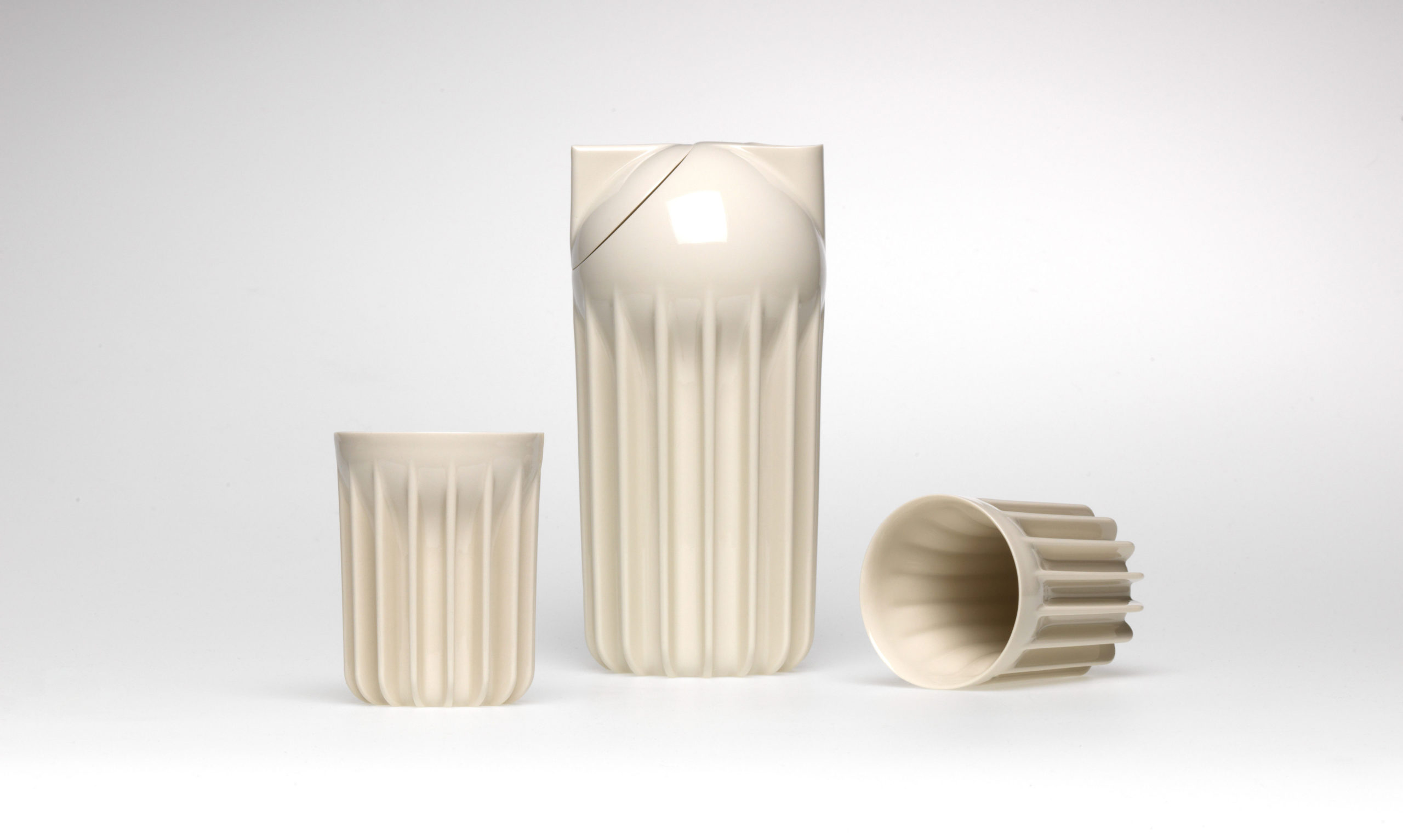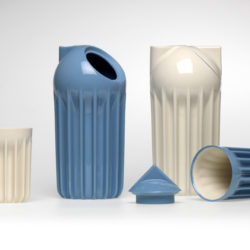ISO16
Description
ISO16 is a coffee set made of Limoges porcelain, which makes it possible to protect the hands from the hot drink.What is the Topic?
The topic of my thesis was "Ceramic insulation mechanisms for hot beverages". My goal was to find out which constructive measures I have to take in order to be able to hold hot beverage cups in my hand without burning my fingers. Through constructive measures, heat-insulating ceramic containers can be produced that do not require handles, double-walled casting or a foreign material as a heat-insulating layer. Most systems try to circumvent the weaknesses of the material in order to compensate for them. The chemical and physical material properties are very good compared to most metals. They are excellently suited for use in design and construction, so that the advantage of the specific material properties is brought to bear and used effectively. My assumption in the run-up to my thesis was that ribs or rib-like structures can protect the hands from the heat. The more porcelain or air there is between my fingers and the hot water, the better the insulating properties.
Why does it look like this?
This draft is the quintessence of my previous research. They combine hard geometric and aspiring forms with soft sensual transitions to create an exciting object. The basic geometry is a conical cylinder. If you look at it more closely, it is actually an upside-down truncated cone, and a sphere that intersects the truncated cone at the quadrant of the sphere. With this shape, one could almost speak of a logical consequence that the jug must look like this. The rotational symmetry of the ribs was given, because all ribs must be able to become smaller towards the centre. The sphere, which forms the end of the jug, is the result of the necessity that porcelain needs as much surface tension as possible to prevent deformation during firing. The lip is the continuation of the rib on the second half of the ball. It is greatly enlarged in dimension, but has the same appearance. The design of the spout does not allow any more irritations. The outflow of the ribs and the spout, caused by the fact that both intersect the basic body of a sphere at its quadrant, creates an exciting, almost dramatic detail. The two different contours create an inside and an outside, which flow into each other in the area of the handle and thus merge into one object. The surface of the inner contour is designed in such a way that the contour of the sphere below the quadrant can be perceived in the best possible way. The observer must be able to mentally complete the shape of the sphere, although the ribs cover most of it. The tapered ribs at the intersection of the sphere, visually lift it up and hold it. The depth of the ribs of approx. 11 mm in combination with the shiny glaze promises an exciting play of light and shadow. I am limited in the dimensions of the filling volume at this point. I have to be careful that the diameter is not too large so that they can be easily lifted with one hand. There are two reasons why the jug must not be too high. On the one hand this increases the volume and thus the weight and the filling volume. On the other hand it must not be too heavy for one hand. The aspect which I think is crucial is the proportions of the jug. If the height is scaled up disproportionately to the diameter, these are the proportions of a carafe. A narrow, elongated silhouette. At this point it was already clear that the spout running to the top would make it impossible to position the lid on top of the jug. This design called for a lid on the back of the sphere at a 45° angle to the axis of symmetry, pointing to the centre. This decision significantly reduces the filling volume, but also creates new possibilities. The large radius of the ribs on the underside of the carafe has been a constructive as well as a design decision. The large radius is first of all a constructive protection against collisions with table tops, worktops or all kinds of other objects that break porcelain. There are no sharp or pointed edges that can easily chip off. The ribs flow into the underside in an arc and increase the standing area by a few millimetres. This contributes to the stability of the jug.
What is special?
Ribbed constructions are currently not found in table culture, but they have enormous potential to develop new design approaches. They protect the hands from hot liquids and in the other direction they also have the potential to cool food, for example by evaporative cooling. The ribs enable the cup or jug to be gripped holistically and safely. The ribs also prevent the vessel from slipping out of your hand. Cups are much easier to handle than cups with an exposed handle.
What is new?
In Europe, we have more or less agreed for centuries on what drinking vessels for hot drinks should look like. The majority of the vessels available today use the principle of an exposed component, which allows hot drinking vessels to be used without the risk of burning themselves. The handle is an independent component of a vessel, which we have added to make it possible to grip the vessel securely. This feature has advantages and disadvantages. In terms of design, it offers a new level to support the functionality and design language. If this is not successful, the handle can act like a foreign body. I think we have become so accustomed to the appearance of cups and mugs as a matter of course that we no longer question the functionality, handling and aesthetics. At least that is my impression. How often have I sat in coffees and been annoyed by the unergonomic handles and protruding cups. I have narrow fingers, so how should people whose fingers are thicker handle these products? In terms of design, handles raise a few questions on closer inspection, but there are a few more when it comes to handling. In order to protect the hand from heat, there are several other approaches to ensure this. - Double-walled - Cuffs - Silicone cords - Velvet sticker - Handle Much of this approach is wrong in terms of design, aesthetics and material and misses the valuable and sustainable approach that porcelain, or ceramic products in general, bring with them. In general, the idea of using ribbed constructions as insulating or cooling components is not new, but in combination with porcelain in the field of tableware it is. Only digital model development, additive manufacturing processes and materials research make this possible.




